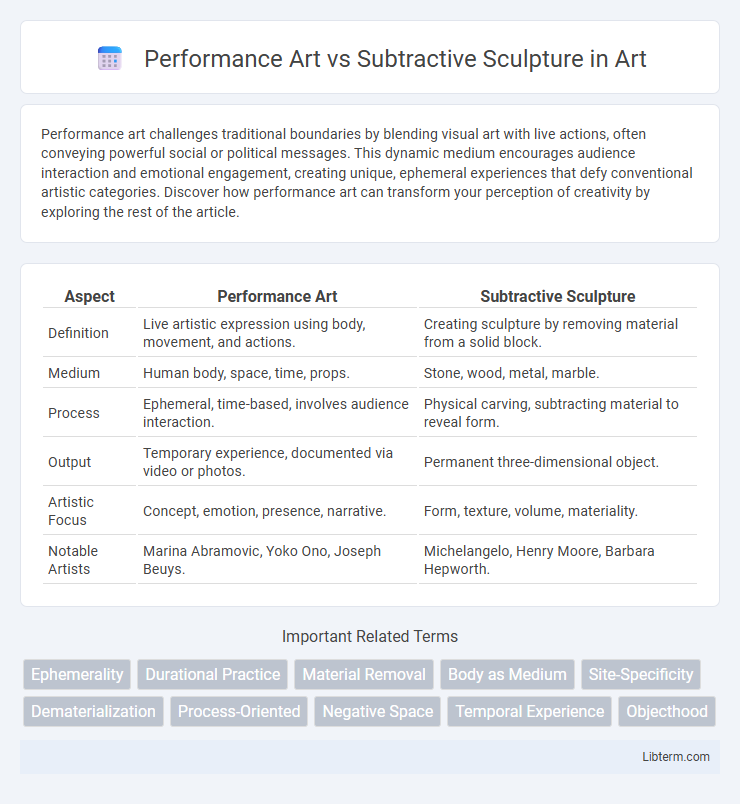Performance art challenges traditional boundaries by blending visual art with live actions, often conveying powerful social or political messages. This dynamic medium encourages audience interaction and emotional engagement, creating unique, ephemeral experiences that defy conventional artistic categories. Discover how performance art can transform your perception of creativity by exploring the rest of the article.
Table of Comparison
| Aspect | Performance Art | Subtractive Sculpture |
|---|---|---|
| Definition | Live artistic expression using body, movement, and actions. | Creating sculpture by removing material from a solid block. |
| Medium | Human body, space, time, props. | Stone, wood, metal, marble. |
| Process | Ephemeral, time-based, involves audience interaction. | Physical carving, subtracting material to reveal form. |
| Output | Temporary experience, documented via video or photos. | Permanent three-dimensional object. |
| Artistic Focus | Concept, emotion, presence, narrative. | Form, texture, volume, materiality. |
| Notable Artists | Marina Abramovic, Yoko Ono, Joseph Beuys. | Michelangelo, Henry Moore, Barbara Hepworth. |
Introduction to Performance Art and Subtractive Sculpture
Performance art emphasizes live, ephemeral experiences where the artist's body and actions become the medium, defying traditional static art forms. Subtractive sculpture involves removing material from a solid block, such as stone or wood, revealing a form through carving or chiseling. Both practices challenge conventional artistic boundaries by exploring presence and materiality in distinct ways.
Historical Origins and Evolution
Performance art emerged in the early 20th century, rooted in Dada and Futurism movements that emphasized live, ephemeral experiences challenging traditional art forms. Subtractive sculpture traces back to ancient civilizations, notably Egyptian and Greek cultures, evolving through the Renaissance with artists like Michelangelo refining techniques by removing material to reveal forms. Both art forms have continuously transformed, with performance art incorporating multimedia and digital elements, while subtractive sculpture explores diverse materials beyond classical marble and stone.
Defining Characteristics of Performance Art
Performance Art is characterized by its live presentation, emphasizing the artist's actions and the ephemeral experience created in real-time, often challenging traditional art forms. It integrates various mediums such as movement, sound, and audience interaction, prioritizing process over a permanent physical object. Unlike Subtractive Sculpture, which involves carving materials like stone or wood to reveal a form, Performance Art exists primarily as an event or action, defying conventional static art boundaries.
Key Features of Subtractive Sculpture
Subtractive sculpture is characterized by the removal of material from a solid mass, typically using tools to carve away stone, wood, or other materials. This method emphasizes precision, control, and the transformation of a raw block into a defined form through chiseling, cutting, or sanding. Unlike performance art, which is temporally driven and often involves live action, subtractive sculpture results in a permanent, tangible object shaped by deliberate physical reduction.
Materials and Mediums Used
Performance art primarily utilizes the human body as its medium, often incorporating ephemeral materials such as fabric, light, sound, and found objects to create transient experiences. In contrast, subtractive sculpture relies on solid materials like stone, wood, or marble, where artists carve away portions to reveal the final form. The tangible, permanent nature of materials in subtractive sculpture contrasts with the temporal, experiential focus of performance art mediums.
Processes and Techniques Compared
Performance art relies on live, temporal actions where the artist's body and environment interact dynamically, emphasizing spontaneity and audience engagement. Subtractive sculpture involves physically removing material such as stone, wood, or metal, using tools like chisels and saws to reveal a form hidden within the raw block. The techniques in subtractive sculpture are precise and controlled, contrasting with the ephemeral and unpredictable processes characteristic of performance art.
The Role of the Artist and Audience
In Performance Art, the artist's role is both creator and performer, actively engaging the audience through real-time interaction and emotional exchange. Subtractive Sculpture positions the artist as a solitary craftsman who transforms raw material by removing elements to reveal the intended form, with the audience experiencing a finished, static art piece. The dynamic, participatory nature of Performance Art contrasts with the contemplative observation typical of finished Subtractive Sculptures, highlighting different relationships between artist and audience.
Temporal vs. Permanent Artistic Forms
Performance art embodies temporal artistic expression, emphasizing live, fleeting experiences that challenge traditional art boundaries through ephemeral interactions. Subtractive sculpture represents permanent artistic forms by physically carving materials like stone or wood, creating enduring objects designed to withstand time. The contrast between these forms highlights the distinction between art as momentary experience and tangible, lasting artifacts in cultural heritage.
Impact and Influence on Contemporary Art
Performance art challenges traditional art forms by prioritizing temporal experience and audience interaction, pushing boundaries of definition and engagement in contemporary art. Subtractive sculpture, through material removal and manipulation, emphasizes physicality and form, deeply influencing modern sculptural practices and concepts of space and materiality. Both uniquely impact contemporary art by expanding modes of expression, with performance art inspiring ephemeral and participatory trends while subtractive sculpture grounds innovation in tactile and structural exploration.
Conclusion: Intersections and Divergences
Performance art and subtractive sculpture intersect in their exploration of space, materiality, and temporality, yet diverge fundamentally in process and medium; performance art emphasizes ephemeral, live experiences while subtractive sculpture involves tangible, permanent alteration of materials. Both art forms challenge traditional boundaries, engaging audiences through sensory and conceptual immersion, though performance art's fluidity contrasts with the static solidity of subtractive works. Understanding these distinctions underscores their unique contributions to contemporary artistic discourse and highlights ongoing dialogues about permanence, material presence, and audience interaction.
Performance Art Infographic

 libterm.com
libterm.com